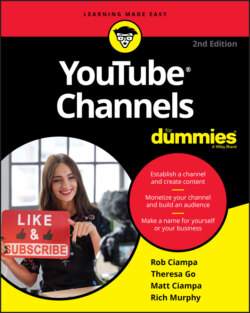Читать книгу YouTube Channels For Dummies - Rob Ciampa - Страница 40
Creating a YouTube Channel
ОглавлениеBuilding a channel is what you came here to do, and now it’s time to get to it. You can do the work to establish your channel after you’ve logged on to YouTube with a Google account. After that’s done, follow these steps to get your channel off the ground:
1 Log on to YouTube, and click the Channel icon in the top right to bring up the YouTube Studio and YouTube Settings pull-down menu, as shown in Figure 2-16.FIGURE 2-16: The YouTube Studio and YouTube Settings pull-down menu.
2 Choose the Create a Channel option from the pull-down menu.A dialog box appears, with “Your creator journey begins” across the top, as shown in Figure 2-17.
3 Click the Get Started link.FIGURE 2-17: Starting to create a YouTube channel.
4 In the new dialog box that appears, choose the name you want to use for your channel.You’re given two options, as shown in Figure 2-18: to use your name or to create a custom name. Sometimes it’s okay to use your real name for your channel. If your content is personality-based (a vlog based around you, for example), this can work just fine. If that's the way you want to go, just click Select under that option and be done with it. However, if you want to go by a different name or are creating a channel for your business, we recommend creating a custom name.
5 To create a custom name, click Select under that option, enter a custom name in the new dialog box that appears (see Figure 2-19), and then click Create.This name can be anything you want and isn’t set in stone. You can change your channel name at any time, though it isn’t to be confused with your custom URL, which we get to later.
6 In the new dialog box that appears (see Figure 2-20), start setting up your new channel.At this point, whether you’ve decided to stick with your own name or come up with an original one, you have the option to set up some crucial details about your channel. Don’t skip this task — it makes your channel more visible and accessible to others:Upload a profile picture, as shown in Figure 2-21: This is the avatar for your channel. Whether someone is on your page or reading a comment you’ve made, this is who they’ll see. As long as it adheres to the correct dimensions and community guidelines, it can be anything you want. FIGURE 2-18: Choosing how you create your channel.FIGURE 2-19: Creating your channel name.FIGURE 2-20: Setting up your new channel.FIGURE 2-21: Uploading a profile picture.Add a channel description, as shown in Figure 2-22: This is the elevator pitch people see when searching your channel. It’s a good way of introducing who you are and what kind of content you make. It’s also a way of making your channel more visible when searched online (also known as search engine optimization, or SEO). Don’t skimp on this; the more descriptive words and phrases you use, the better off you are.Link your websites, as shown in Figure 2-23: Whether it’s a website or a social media page, link them here. This enables you to easily drive traffic to whatever page you’re trying to promote.
7 When you finish setting up your channel, click the Save and Continue button. (Refer to Figure 2-23.)
FIGURE 2-22: Adding a channel description.
You are now the proud owner of a channel with no content and a boring default layout. (Check out Figure 2-24 to see what we mean.) If you gave your channel a new name, by clicking your avatar in the top right, you’ll notice that your name has changed from your Google account name to your brand-spanking-new channel name. But all that is covered in Chapter 3. You have even more account setup tasks to complete.
FIGURE 2-23: Adding links to your websites.
FIGURE 2-24: The default channel layout, which is boring.
